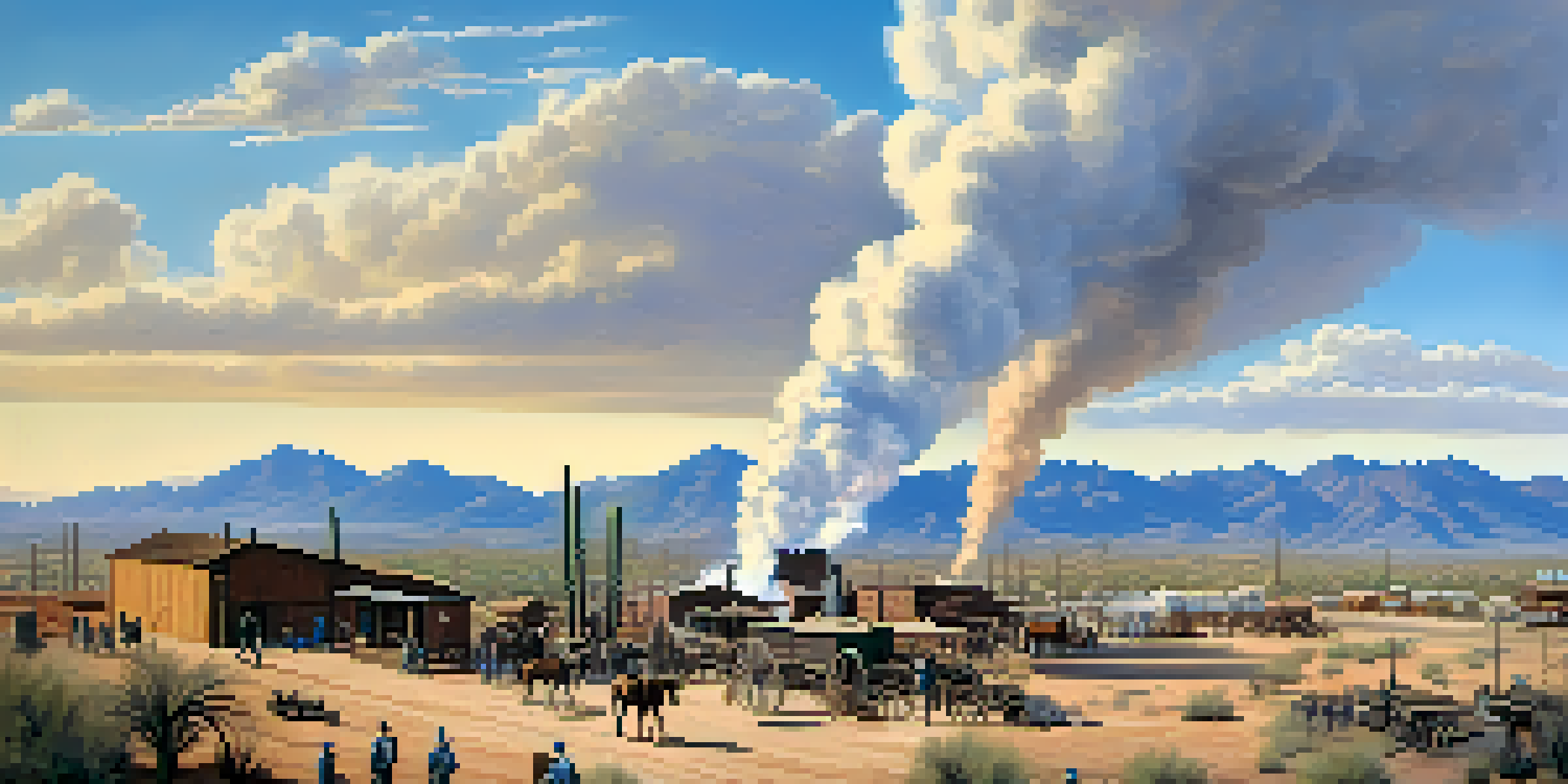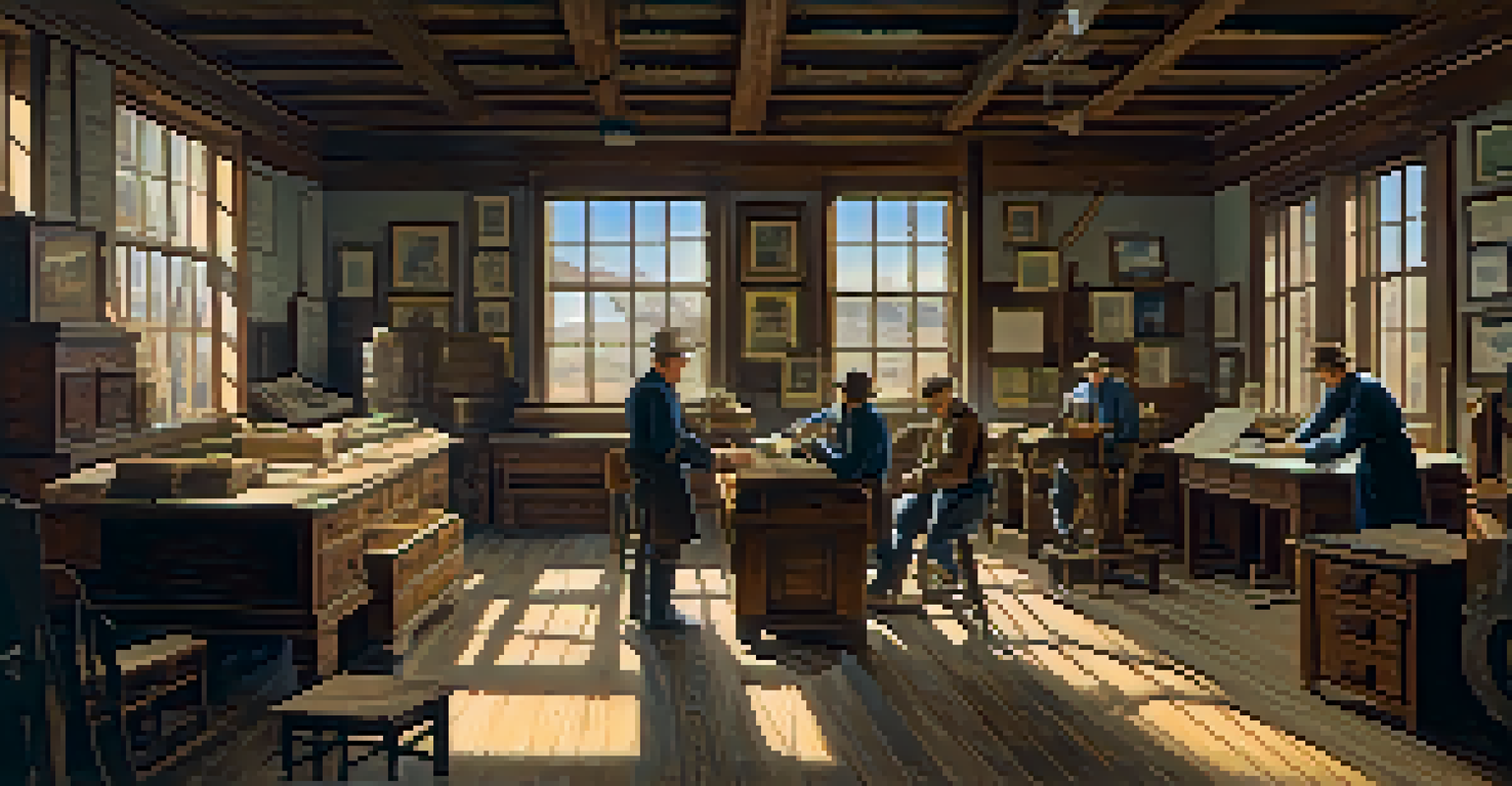The Rise of Tucson's Mining Industry in the 19th Century

The Historical Context of Tucson's Mining Boom
In the 19th century, Tucson was a small town on the cusp of transformation. Nestled in the Sonoran Desert, its potential lay largely untapped until the discovery of valuable minerals. As the United States expanded westward, the mining industry began to flourish, attracting prospectors and entrepreneurs eager to strike it rich.
The mining industry is a significant contributor to the history and development of Tucson, shaping its economy and cultural identity.
The discovery of silver, copper, and other minerals sparked immense interest in the region. Tucson's strategic location made it an ideal hub for mining operations, leading to a surge in population and infrastructure development. This growth laid the foundation for what would become a vibrant mining community.
By the mid-1800s, Tucson had evolved from a modest settlement into a bustling center of commerce. The mining boom not only transformed the local economy but also shaped the cultural landscape, as diverse groups of people converged in search of opportunity.
The Role of Railroads in Mining Expansion
With the advent of railroads in the late 1800s, Tucson's mining industry experienced an unprecedented boost. Rail lines connected remote mining sites to Tucson, facilitating the transportation of minerals and supplies. This newfound accessibility allowed for more efficient operations and encouraged further investment in mining ventures.

As trains brought in resources and carried away precious metals, Tucson became a vital link in the broader mining network of the Southwest. The increased mobility also attracted more miners and their families, creating a thriving community around the mining industry. Towns began to sprout up around these rail lines, further fuelling the economic growth.
Tucson's Mining Boom Transformed It
The discovery of valuable minerals in the 19th century led to Tucson's rapid population growth and economic development, establishing it as a key mining hub.
Moreover, railroads enabled Tucson to export its minerals to national and international markets. The demand for copper and silver surged, particularly during events like the Civil War, leading to a boom that would cement Tucson's reputation as a mining powerhouse.
Key Mining Companies and Their Impact
Several key mining companies emerged during Tucson's 19th-century boom, each leaving a significant mark on the industry. Companies like the Arizona Mining Company and the Pima Mining Company became household names, drawing workers and investments. Their successes showcased the profitability of mining in the region.
In every adversity lies the seed of opportunity, and Tucson's mining boom exemplified this principle as it transformed a modest settlement into a thriving community.
These companies not only extracted minerals but also invested in local infrastructure, such as schools and hospitals, contributing to the community's overall development. As they flourished, they attracted skilled laborers and created jobs, further bolstering Tucson's economy.
However, this rapid growth also came with challenges, including labor disputes and environmental concerns. The balance between economic gain and responsible practices became a topic of discussion as the mining industry expanded, setting the stage for future debates.
The Cultural Impact of Mining on Tucson
The mining boom in Tucson brought together a melting pot of cultures, as workers from various backgrounds flocked to the area. This diversity enriched the local culture, leading to unique traditions, cuisines, and social dynamics. The blending of cultures created a vibrant community that celebrated its shared experiences.
As miners shared their stories and traditions, Tucson developed a distinct identity that resonated with both locals and visitors. Festivals, music, and art began to reflect the mining heritage, highlighting the importance of this industry in shaping the town's character.
Railroads Fueled Mining Expansion
The introduction of railroads in the late 1800s connected Tucson to remote mining sites, enhancing mineral transportation and boosting the local economy.
However, the cultural impact wasn't solely positive. The influx of workers also led to social tensions and competition for resources, highlighting the complexities of a rapidly growing economy. These dynamics would continue to evolve as Tucson navigated its identity amid the mining boom.
Challenges Faced by Tucson's Mining Industry
Despite its initial success, Tucson's mining industry faced numerous challenges throughout the 19th century. Fluctuating market prices for minerals created uncertainty, leading to boom-and-bust cycles that affected local economies. Miners often found themselves at the mercy of these economic shifts.
Labor conditions were another significant concern, as many workers faced dangerous environments and long hours. Strikes and labor disputes became commonplace as miners sought better wages and safer conditions. These challenges underscored the human cost of the mining boom, adding complexity to the narrative of Tucson's growth.
Environmental impacts also emerged as a pressing issue, with mining operations leaving lasting scars on the landscape. As awareness grew regarding these environmental concerns, the conversation shifted toward sustainability and responsible mining practices, setting the stage for future industry regulations.
The Legacy of 19th Century Mining in Tucson
The legacy of Tucson's 19th-century mining boom is still evident today, influencing the region's economy and culture. While mining may not be as dominant as it once was, its impact on the community remains ingrained in the local identity. Historic sites and museums celebrate this rich heritage, drawing visitors interested in Tucson's past.
Moreover, the skills and innovations developed during this era have paved the way for modern industries. Mining engineers and laborers from this period contributed to advancements in technology and resource management, influencing sectors beyond mining.
Cultural Diversity Shaped Tucson
The influx of miners from various backgrounds during the mining boom created a rich cultural tapestry, influencing traditions and community dynamics in Tucson.
As Tucson continues to evolve, the stories of its mining past serve as reminders of resilience and adaptability. The challenges and triumphs of this era have shaped the community's approach to growth, sustainability, and cultural preservation.
Looking Ahead: Tucson's Future Beyond Mining
As Tucson moves into the future, it faces exciting opportunities beyond its mining legacy. While the mining industry played a crucial role in shaping the city, today’s economy is diversifying with technology, tourism, and education becoming increasingly important. This shift reflects a broader trend of cities adapting to changing economic landscapes.
The focus on sustainability and environmental stewardship is now at the forefront of Tucson's development. As awareness of climate change and resource management grows, the city is embracing green technologies and practices, creating a new narrative that honors its past while looking toward a sustainable future.

Ultimately, Tucson's journey from a mining town to a modern city showcases the power of adaptation. By learning from its history, Tucson is poised to thrive in a rapidly changing world while maintaining a connection to its rich heritage.